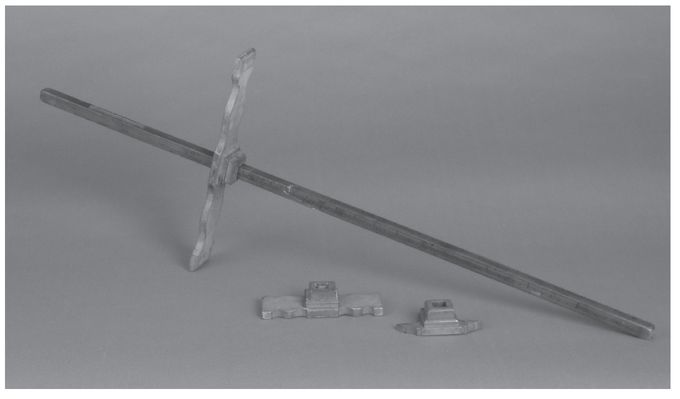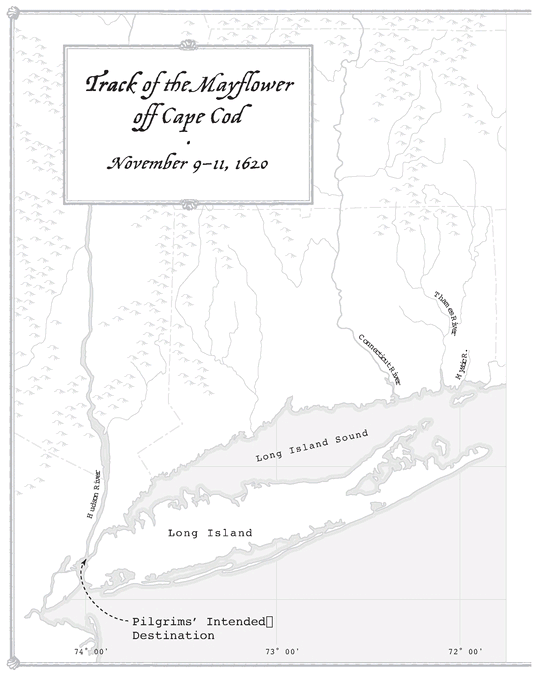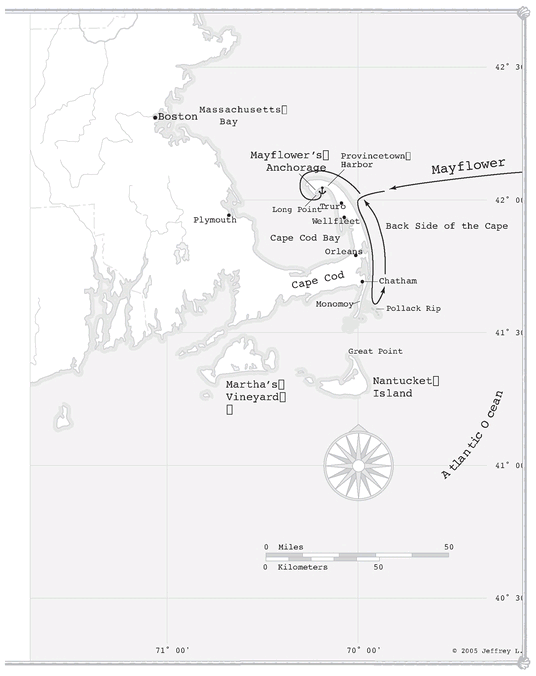The Mayflower and the Pilgrims' New World* (6 page)
Read The Mayflower and the Pilgrims' New World* Online
Authors: Nathaniel Philbrick
Tags: #Retail, #Ages 10+

BOOK: The Mayflower and the Pilgrims' New World*
10.79Mb size Format: txt, pdf, ePub
That should have been the end of him. But dangling over the side and trailing behind the ship was the topsail halyard, the rope used to raise and lower the upper sail. Howland was in his midtwenties and strong. When his hand found the halyard, he gripped the rope with such desperation that even though he was pulled down more than ten feet below the ocean's surface, he never let go. several sailors hauled Howland back in, finally snagging him with a boat hook and dragging him up onto the deck.
When William Bradford wrote about this incident more than a decade later, John Howland was not only alive and well, but he and his wife, Elizabeth, were on their way to raising ten children, who would, in turn, produce an astounding eighty-eight grandchildren. A Puritan believed that everything happened for a reason. Whether it was the salvation of John Howland or the death of the profane young sailor, it occurred because God had made it so. If something good happened to the Pilgrims, it was inevitably interpreted as a sign of God's approval. But if something bad happened, it didn't necessarily mean that God disapproved; it might mean that he was testing them for a higher purpose. And as all aboard the
Mayflower
knew, the true test was yet to come.
Mayflower
knew, the true test was yet to come.

â
Cross-staff: navigational instrument used to measure latitude. By pointing at the sun and sliding the vane along the notched staff, a sailor could calculate the angles to arrive at latitude.
Cross-staff: navigational instrument used to measure latitude. By pointing at the sun and sliding the vane along the notched staff, a sailor could calculate the angles to arrive at latitude.
âââ Unknown to Jones and any other sailor of the day was the presence of the Gulf streamâa current of warm water flowing up from the Caribbean along the North American coast, across the Atlantic, and past the British Isles. sailing against the Gulf stream would slow down any voyage, and the
Mayflower
had managed an average speed of just two miles an hour since leaving England back in september.
Mayflower
had managed an average speed of just two miles an hour since leaving England back in september.
Jones had a cross-staff, a three-foot-long stick that enabled him to calculate his latitude, or north-south position, within a few miles. But he had no reliable way of determining his longitude, or east-west position. This meant that after all the bad weather they'd encountered, Jones had only the vaguest idea of how far he was from land.
He knew the
Mayflower
was well north of her destination, the mouth of the Hudson River. But at this late stage in the voyage, with disease beginning to appear among the passengers and crew, Jones needed to find his way to the coast as quickly as possible. so he made a run for it, sailing west along a latitude that would lead him to the sandy peninsula known to most sailors of the time as Cape Cod. Reaching out to them like an upturned arm, the Cape was as good a target as any.
Mayflower
was well north of her destination, the mouth of the Hudson River. But at this late stage in the voyage, with disease beginning to appear among the passengers and crew, Jones needed to find his way to the coast as quickly as possible. so he made a run for it, sailing west along a latitude that would lead him to the sandy peninsula known to most sailors of the time as Cape Cod. Reaching out to them like an upturned arm, the Cape was as good a target as any.
The
Mayflower
pushed on until they were within smelling distance of the shore. seagulls began to appear in the sky, and the color of the water changed from deep blue to pale green. And then, at daybreak on Thursday, November 9, 1620, after sixty-five days at sea, they saw land.
Mayflower
pushed on until they were within smelling distance of the shore. seagulls began to appear in the sky, and the color of the water changed from deep blue to pale green. And then, at daybreak on Thursday, November 9, 1620, after sixty-five days at sea, they saw land.
TWO
The Compact

IT WAS A beautiful late-fall morningâclear skies and light winds out of the northwest. There was a thin slice of moon overhead, gradually fading to nothingness as the sun rose behind them in the east. Up ahead to the west was what Jones believed to be the forearm of Cape Cod. This thirty-mile stretch of beach runs from north to south and is edged by dramatic hundred-foot-high cliffs of sand, which must have been instantly recognizable to those of Jones's pilots who had been in this region before. stretching behind the cliffs were rolling, tree-covered hills.
The
Mayflower
's passengers were, according to Bradford, “not a little joyful.” On a crisp autumn day in New England the colors seem brighter, and the Pilgrims were “much comforted ... [by] seeing so goodly a land, and wooded to the brink of the sea.”
Mayflower
's passengers were, according to Bradford, “not a little joyful.” On a crisp autumn day in New England the colors seem brighter, and the Pilgrims were “much comforted ... [by] seeing so goodly a land, and wooded to the brink of the sea.”
Now they had a decision to make: Where should they go? They were well to the north of their intended destination. And yet there were reasons to consider the region around Cape Cod as a possible settlement site. In the final chaotic months before their departure from England, Weston and others had begun to insist that a more northern site in New Englandâwhich was the new name for what are now the states of Massachusetts, Connecticut, Rhode Island, Maine, New Hampshire, and Vermontâwas a better place to settle.
As Cape Cod's name indicates, this area was famous for the large schools of codfish that swam by its shores. Come spring, hundreds of codfishing vessels from England, France, Holland, and other European countries fished the waters of New England. A colony established on Cape Cod could take advantage of this profitable fishery. But when the
Mayflower
had departed from England, it had been impossible to secure a patent for this region. If they were to settle where they had legally been granted land, they had to sail south for the mouth of the Hudson River 220 miles away.
Mayflower
had departed from England, it had been impossible to secure a patent for this region. If they were to settle where they had legally been granted land, they had to sail south for the mouth of the Hudson River 220 miles away.

â
Photograph of William Bradford's passenger list, taken from an 1896 facsimile edition of his handwritten history
Of Plymouth Plantation.
Photograph of William Bradford's passenger list, taken from an 1896 facsimile edition of his handwritten history
Of Plymouth Plantation.
Unfortunately, there was no reliable English map of the waters between Cape Cod and the Hudson. Little had changed since 1614, when Captain John smith (of Pocahontas fame) had dismissed all existing maps of the region as “so much waste paper, though they cost me more.” smith's own chart of New England only went as far south as the back side of the Capeâwhere the
Mayflower
had first sighted landâand provided no help for a voyage south. Except for what knowledge Jones's pilots might have of this coastâwhich appears to have been minimalâthe captain was sailing blind.
Mayflower
had first sighted landâand provided no help for a voyage south. Except for what knowledge Jones's pilots might have of this coastâwhich appears to have been minimalâthe captain was sailing blind.
For the next five hours, the
Mayflower
sailed easily along. After sixty-five days of storms, it must have been wonderful for the passengers, who crowded onto the chilly, sun-drenched deck to drink in their first view of the New World. But for Master Jones, it was the beginning of the most tense portion of the voyage. Any captain would rather have braved the fiercest North Atlantic storm than risk the danger of an unknown coast. Until the
Mayflower
was quietly at anchor, Jones would get little sleep.
Mayflower
sailed easily along. After sixty-five days of storms, it must have been wonderful for the passengers, who crowded onto the chilly, sun-drenched deck to drink in their first view of the New World. But for Master Jones, it was the beginning of the most tense portion of the voyage. Any captain would rather have braved the fiercest North Atlantic storm than risk the danger of an unknown coast. Until the
Mayflower
was quietly at anchor, Jones would get little sleep.
The
Mayflower
sailed south past the future locations of Wellfleet, Eastham, Orleans, and Chatham. Throughout the morning, the tide was in their favor, but around 1 P.M., it began to flow against them. Then the water dropped alarmingly, as did the wind. suddenly, the
Mayflower
was in the midst of what has been called “one of the meanest stretches of shoal [shallow] water on the American coast”âPollack Rip.
Mayflower
sailed south past the future locations of Wellfleet, Eastham, Orleans, and Chatham. Throughout the morning, the tide was in their favor, but around 1 P.M., it began to flow against them. Then the water dropped alarmingly, as did the wind. suddenly, the
Mayflower
was in the midst of what has been called “one of the meanest stretches of shoal [shallow] water on the American coast”âPollack Rip.
Pollack Rip is part of a complex and ever-changing maze of sandbars stretching between the elbow of Cape Cod and the tip of Nantucket Island, fifteen or so miles to the south. The huge volume of water that moves back and forth between the ocean to the east and Nantucket sound to the west rushes and swirls amid these shoals with a ferocity that is still, almost four hundred years later, terrifying to behold. It's been claimed that half the wrecks along the entire Atlantic and Gulf coasts of the United states have occurred in this area.
The calm waters had suddenly been transformed into a churning sea. And with the wind dying to almost nothing, Jones had no way to get his ship away from the danger, especially since what breeze remained was from the north, pinning the
Mayflower
against the breakers. It was approaching 3 P.M., with only another hour and a half of daylight left.
Mayflower
against the breakers. It was approaching 3 P.M., with only another hour and a half of daylight left.
Just when it seemed that all had been lost, the wind began to change, gradually shifting in a clockwise direction to the south. This, combined with a fair tide, was all Master Jones needed. By sunset at 4:35 P.M., the
Mayflower
had turned around and was well to the northwest of Pollack Rip.
Mayflower
had turned around and was well to the northwest of Pollack Rip.
With the wind building from the south, Jones made a historic decision. They weren't going to the Hudson River. They would keep going north, back around Cape Cod to New England.
Â
âââ By 5 P.M., it was almost completely dark. Not wanting to run into any more shoals, Jones decided to “heave to,” adjusting the sails so that the ship was barely movingâstandard procedure on an unknown coast at night. Four or five miles off present-day Chatham, the
Mayflower
drifted with the tide, waiting for dawn.
Mayflower
drifted with the tide, waiting for dawn.
In the meantime, the news that they were headed to New England instead of the Hudson River put the passengers in an uproar. As they all knew, their patent did not technically apply to a settlement north of the Hudson. some of the strangers made “discontented and mutinous speeches,” insisting that “when they came ashore they would use their own liberty, for none had power to command them.”


It was now clear that the future of the settlement was, once again, in serious danger. The strangers were about half the passengers, and unlike the Leideners, they had little holding them together except, in some cases, a growing reluctance to live in a community dominated by religious fanatics. On the other hand, some of the strangers, including the
Mayflower
's governor, Christopher Martin, had strong ties to the Adventurers in London; in fact, passenger William Mullins was an Adventurer himself. These strangers recognized that the only way for the settlement to succeed financially was if everyone worked together. Before they landed, it was essential that they all sign a formal and binding agreement of some sort. Over the course of the next day, they hammered out what has come to be known as the Mayflower Compact.
Mayflower
's governor, Christopher Martin, had strong ties to the Adventurers in London; in fact, passenger William Mullins was an Adventurer himself. These strangers recognized that the only way for the settlement to succeed financially was if everyone worked together. Before they landed, it was essential that they all sign a formal and binding agreement of some sort. Over the course of the next day, they hammered out what has come to be known as the Mayflower Compact.
Other books
Murder on the Short List by Peter Lovesey
A Fatal Vineyard Season by Philip R. Craig
1. Just One Damned Thing After Another by Jodi Taylor
When She Was Gone by Gwendolen Gross
Small Town Sinners by Melissa Walker
Happily Ever Afton by Kelly Curry
The Regal Rules for Girls by Fine, Jerramy
Fractured by Erin Hayes
Daddy Long Stroke by Cairo